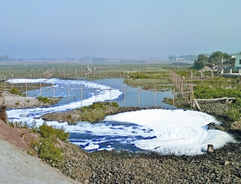Water Pollution
Water Pollution Water is considered polluted when it is altered from the natural state in its physical condition, and chemical and microbiological composition, so that it becomes unsuitable or less suitable for any safe and beneficial consumption. The term contamination is used synonymously with pollution. The signs of water pollution are obvious: bad taste; offensive odours from lakes, rivers and sea beaches; unchecked growth of aquatic weeds in water bodies; decrease in number of aquatic animals in surface water bodies; oil and grease floating on water surfaces; colouration of water; etc. Besides these obvious signs, there are other kinds of pollution, which are not so visible.

Sources of pollution Factories, power plants and sewage treatment plants are considered point sources of water pollution, because they emit pollutants at discrete locations, usually through a pipe that leads to a lake or stream. Nonpoint sources of water pollution are scattered or diffused. Cropland, forests, urban and suburban lands, roadways, and parking lots are nonpoint sources of a variety of substances including dust, sediment, pesticides, asbestos, fertiliser, heavy metals, salts, oil, grease, litter, and even air pollutants washed down from the cloud by rain.
Water pollution can also be categorised into natural and anthropogenic sources. Natural sources are those which take place without human influence. Anthropogenic pollution are those which are induced by human beings. Natural pollution can also be accentuated by human activities.
Pollution takes place in all the three main sources of water, ie rain water, surface water and groundwater. Surface water is more susceptible than groundwater, which is naturally protected from surface activities.
Rainwater pollution Acid rain damages forests and may cause significant decrease in productivity. Numerous authors have also raised concern for crop damage. Acid rain is particularly damaging to buds; therefore, acids falling on plants in springtime may impair growth. Acidification of soil may also impair soil bacteria that play an important role in nutrient cycling and nitrogen fixation. Acid rain is also capable of corroding manmade structures. Examples of such corrosion are: the Statue of Liberty, the Canadian Parliament in Ottawa and Egypt's temple at Karnak. Acid rain may also damage house paint and etch the surfaces of automobiles. There is no record of acid rain in Bangladesh. However, due to extensive air pollution in Dhaka city, it is very likely that rain water in Dhaka would be more acidic than rain water in rural areas.
Surface water pollution Surface water occurs in oceans, rivers, lakes, ponds and floodplains. It has been the source of water supply since the dawn of civilisation. But intense human activities have been polluting these readily available sources. Surface water used to be the primary source of water supply in Bangladesh, but it is no longer the case. Surface water in Bangladesh is extensively polluted by sources such as industrial and urban wastes, agrochemicals and sewerage wastes and seawater intrusion. Surface water bodies are extensively used for disposal of untreated industrial wastes and this is one of the main sources of pollution. The buriganga is a typical example of serious surface water contamination. Apart from industrial sources, surface water in the country is also extensively contaminated by human faeces as sanitation in general is poor. Agrochemicals are extensively used in the country causing pollution of surface water. Due to withdrawal of water from the ganges, seawater intrudes a long way inside the coastline which causes river water pollution by salinity. There are also other minor sources that contaminate surface water extensively.
Groundwater pollution Although groundwater is not directly exposed to surface polluting activities, numerous natural and anthropogenic activities cause groundwater pollution. A number of physical, chemical and biochemical (and microbiological) processes cause alteration of groundwater properties either by addition of new elements/ions/compounds or by increasing the existing concentrations. Before the discovery of arsenic contamination in Bangladesh, groundwater used to be considered a safer source of drinking water. Arsenic contamination of groundwater in Bangladesh is now considered the world's largest case of water pollution. Groundwater in Bangladesh is also polluted by a number of anthropogenic and natural sources. The most widespread anthropogenic sources are the infiltration of industrial and urban wastes disposed on the ground or in surface water bodies. Also intrusion or infiltration of saline water contaminates groundwater. Extensive use of agrochemicals can lead to groundwater pollution. Leaking sewers/septic tanks/pit latrines also cause groundwater pollution. [Kazi Matinuddin Ahmed]
See also arsenic.
